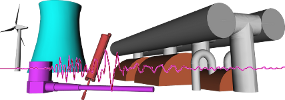 |
Surveillance 8 |
 |
|
|
|
Keynote SpeakersMarc Thomas (ETS, Montréal Canada) Machinery monitoring: from modelling to feature selection for fault diagnosis In a predictive machinery maintenance process and machinery monitoring, bearings and gears are parts being the most exposed and consequently more subject to degradation. In order to explain the dynamic behavior of bearings and gears subjected to defects, it may be necessary to develop dynamic models. For bearing analysis, numerical simulations for computing the vibration responses of a ball bearing affected by a localized defect are developed by using discretized mass-spring-damper systems with three, five and twenty degrees of freedom. The generation of vibration by a point defect in a rolling element bearing is modeled as a function of the rotation of the bearing, the distribution of the load in the bearing, the transfer function between the bearing and the transducer, the elasticity of the bearing structure, and the Elasto-Hydro-Dynamic oil film characteristics. For gear analysis, a one-stage mass-spring-damper 6-DOF gear dynamic model with lateral vibration is developed for computing the vibration response due to tooth cracks. The sensitivity and efficiency of features for detecting faults is investigated both in time and frequency domains. Various experimental applications are described. Biography Marc Thomas, Eng. (INSA, Lyon), M.Sc. A, Ph.D. (Sherbrook University) is an expert in machinery vibrations, modal analysis, damping identification, and structural health monitoring. His researches cover various fields ranging from vibration control with smart structures (electro-rheological fluids) to human exposition to vibration. He is the director of the DYNAMO laboratory in process, machinery and structural dynamics. He is titular professor at ETS in the mechanical engineering department since 24 years. Previously, Professor Thomas has been the leader of the structural Dynamics team of the Quebec Industrial Research Center (CRIQ) during 11 years. He has published over 270 papers and supervised over 34 graduated students. He is now mentor of the Canadian Machinery Vibration Association (CMVA).
Tomasz Barszcz (AGH Krakow, EC Systems, Poland) How to bridge academia and industry? A practitioner’s perspectives Innovation is a must for a modern economy. There are several sources of growth of the high added value industry sectors and innovation is probably the most sustainable of them. This is one of the reasons why countries all over the world spend enormous funds on promoting innovation, both in academia and in industry. Biography Prof Tomasz Barszcz received the M.Sc. degree in Electric Engineering/ Automatic Control from the Technical University of Gdansk in 1993, Ph.D. in Mechatronics and D.Sc. in Automation and Robotics in 2009 from the AGH University of Science and Technology in 1997. In 1994-2000 he worked in ABB and ALSTOM Power, up to the level of Development Department manager. In 2000 he started his employment at the AGH University of Science and Technology, Kraków, Poland. His research activities in Machinery Monitoring, Vibration Signal Processing, Distributed Systems include: damage detection methods, advanced signal processing, analysis and simulation of vibration processes in machinery and structures, distributed computer systems for monitoring and diagnostics, diagnostic centers. He is the author of 4 books and over 160 papers. Prof Barszcz is the general secretary of PTDT (Polish Society of Technical Diagnostics).
Renata Klein (RK Diagnostics, Israel) Automatic diagnostics of complex machinery An automatic diagnostic process is performed in several consecutive major stages. These stages are: data acquisition, data validation, data selection, signal processing, feature extraction, health assessment (per component), and fusion of the health indicators for diagnostics of the machine. When a human is involved in the diagnostics, all stages except for the stage of signal processing, are usually done visually and based on reasoning and experience. In that situation, the signal processing presents the most complex problem. Therefore, it was thoroughly investigated in the recent decades. Extensive academic research was published and implemented in industrial systems (mainly HUMS for the aviation industry). If the damage signs are observable in the signatures generated in the signal processing stage, the damage is detected and identified. When the goal is to create a fully automated process, with no human involvement, the quality of all the other stages, and in particular the feature extraction and health assessment stages, become crucial for a reliable diagnostics decision. The reliability of a diagnostics system is determined by the rate of false alarms and the rate of misdetections. True condition based maintenance requires a high reliability system, with a low rate of false alarms and a low rate of misdetections. In automatic systems, the reliability of the final diagnostics decision depends on the quality of all the diagnostics stages. The data validation and data selection stages are important because they provide input to the computing intensive signal processing of wideband signals. The signal processing of the vibro-acoustic data is very complex and demanding because of the richness of information that it carries, requiring sophisticated methods for separation of the excitation sources. In the feature extraction stage, the system scans for the characteristics of all possible patterns belonging to the different failure modes of each component, resulting in a huge amount of features (tens for each bearing, hundreds for each gear pair). In the stages up to feature extraction the main concern is to avoid misdetections. The information on a possible damage not emphasized in the signal processing stage or not characterized in the feature extraction stage is lost. The main role of the later stages (health assessment and fusion) is to reduce the amount of false alarms and to determine the severity of damage. This talk will review the roles of the different diagnostics stages, focusing mainly on the feature extraction stage. The main complexity of the feature extraction arises from the need to extract automatically all the relevant information which is needed for the later health assessment. The challenge is to translate expert impressions into quantifiable parameters, obtained automatically. Different approaches for feature extraction will be discussed, analyzing their advantages and drawbacks, in the context of an automatic system. The different feature extraction approaches will be illustrated with data examples of real cases. Biography Renata Klein received her B.Sc. in Physics and Ph.D. in the field of Signal Processing from the Technion, Israel Institute of Technology. In the first 17 years of her professional career, she worked in ADA-Rafael, the Israeli Armament Development Authority, where she managed the Vibration Analysis department. In the next 14 years, she focused on development of automatic health management systems for machinery. She invented and managed the development of vibration based diagnostics and prognostics systems that are used successfully by the Israeli Air Force in its combat helicopters and UAV fleets, and by leading jet engine manufacturers. Renata is a lecturer at the faculty of Mechanical Engineering in Ben Gurion University of the Negev, where she supervises research in the area of vibration based Diagnostics and Prognostics. In the recent years, Renata is the CEO and owner of “R.K. Diagnostics”, providing R&D services and algorithms to companies who wish to integrate machinery health management and prognostics capabilities in their products.
|

